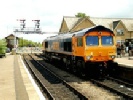Archive Section




An account of the lecture by Bernard Gambrill, Head of Public Affairs at Union Railways, written by Peter Lindop
7th May 2002
Bernard has been with the company for 13 year previous projects include involvement with the Bournemouth electrification, Great Northern Electrification, and Great Western high-
The 5.2 billion Channel Tunnel Rail Link (CTRL) is set out in the 1996 Act. It is partly funded by the European Union and will form part of the Trans European Network, for completion in 2008/9. London & Continental Railway (LCR) was selected in 1996 to build and operate CTRL with Eurostar (UK). The first slide showed the organisation, with (LCR) DTLR Railtrack and Union Railways chiefly involved. A consortium called Rail Link Engineering is managing the construction. The next slide was a financial chart, but that was complicated when seen, let alone to try to explain here Despite their troubles, Railtrack is still expected to buy Section 1.
The new line is being built in two parts: Section 1: is from the Channel Tunnel to Fawkham Junction (North Kent), joining the current rail network and is 74km or 46 miles long. Construction started in October 1998. Section 2: which started July 2001 is from Southfleet Junction to London St. Pancras and is 39km or 24 miles long. Each section is then split into smaller areas; 7 main Contracts for Section 1, and 16 main Contracts for Section 2. It is expected Section 1 will open in September 2003 with trains going into Waterloo. The whole line will open in 2007, saving 35 minutes on the British section of the journey. With extra capacity available with the new line, more Eurostar services will be operated.
A study in 1988 evaluated routes for the new line and came down to a choice of four. Slides illustrated these routes, and some of the arguments for and against each route. One then reduced this, these followed the A2-
Stations on the CTRL are the present Ashford International and a new stations at Ebbsfieet, where domestic services from North Kent join the route, and Stratford. The line ends at the rebuilt St. Pancras. The line is built to UIC "C" gauge; it had to be to get European money! This is large enough for freight trains, except for platforms at St. Pancras and Ashford stations which are "B" gauge. A slide illustrated all the different gauges.
A total of 14 tunnels need to be constructed. The longest being the London Tunnel, 19Km (12 miles) from Islington, just above the ECML, to Dagenham. The line briefly comes to the surface for Stratford Station. This will be a joint domestic/ international station, and the London stop for Eurostar services running north of London. It is being built as a large box, with a line for E.C.S. trains rising through the middle. Five huge shafts of 17.15 metres diameter ventilate the twin bore, single-
A difficult section of the route is as it passes under the River Thames, and crosses the M25 at Thurrock. For the Thames crossing (a 3km twin-
Another series of slides illustrated the Eurostar cabs, and the TVM430 cab signalling. These, it was explained, count down from max speed to a stop in conjunction with trackside markers. The line will also see freight trains, but this will have to be carefully planned -
A new large rail yard/centre has been built north of Ashford to construct Section 1. Called Beechbrook Farm, it was a green field site, and will be grassed over when the line is finished. Track construction and laying as well as overhead line equipment trains are assembled and sent out from this site. Locomotive and wagons are maintained and fuelled on site.
The end of the new line is St. Pancras Station, the Grade 1 listed original Midland Railway station being completely rebuilt and enlarged. The present platforms will be doubled in length for Eurostar trains, becoming the International Station. Seven new platforms will be built at the end of the current station, those on the west for Midland Mainline services. On the east will be the new domestic services from Kent via the CTRL. Underneath, a new Thameslink station is being built with 12 coach long platforms, with a new tunnel link to the ECML. A new large booking hall and connecting passageways are being excavated for London Underground. Above, the original Midland Grand Hotel is also being rebuilt, with a luxury hotel on the lower floors, and exclusive apartments on upper floors. The 1868 trainshed roof will also be refurbished and reglazed. The choice of who runs the domestic services has yet to be decided by the Strategic Rail Authority.
To finish Bernard showed some slides illustrating the new services along the CTRL. Both domestic and European services will be increased in frequency, and journey times shortened. After some questions, we gave Bernard a round of applause for an interesting talk. For more details, and updated information, visit the Website: www.ctrl.co.uk